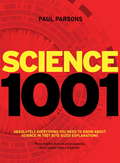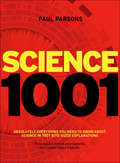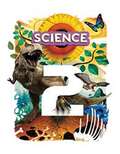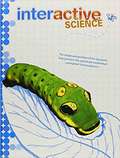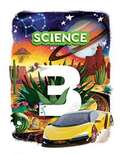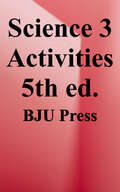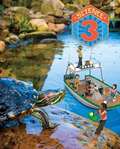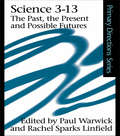- Table View
- List View
Science (New York)
by Jim Cummins Timothy Cooney James Flood Barbara Kay Foots M. Jenice Goldston Shirley Gholston Key Diane Lapp Sheryl A. Mercier Karen L. Ostlund Nancy Romance William Tate Kathryn C. Thornton Leon Ukens Steve WeinbergHardbound Pupil Editions for Grades 1-6 are organized into four units-Life, Physical, Earth, and Human Body sciences. An age-appropriate workbook is available for Kindergarten students.
Science (Ohio Edition )
by HarcourtThis Science, Ohio Edition contains Earth and Space Sciences, Life Sciences, Physical Sciences, Ohio Expeditions, etc.
Science (Ohio)
by Jim Cummins Timothy Cooney James Flood Barbara Kay Foots M. Jenice Goldston Shirley Gholston Key Diane Lapp Sheryl A. Mercier Karen L. Ostlund Nancy Romance William Tate Kathryn C. Thornton Leon Ukens Steve WeinbergHardbound Pupil Editions for Grades 1-6 are organized into four units-Life, Physical, Earth, and Human Body sciences. An age-appropriate workbook is available for Kindergarten students.
Science (Ohio)
by Jim Cummins Timothy Cooney James Flood Barbara Kay Foots M. Jenice Goldston Shirley Gholston Key Diane Lapp Sheryl A. Mercier Karen L. Ostlund Nancy Romance William Tate Kathryn C. Thornton Leon Ukens Steve WeinbergScott Foresman Science ( 2003)
Science (Scott Foresman Science, 2003)
by Jim Cummins Timothy Cooney James Flood Barbara Kay Foots M. Jenice Goldston Shirley Gholston Key Diane Lapp Sheryl A. Mercier Karen L. Ostlund Nancy Romance William Tate Kathryn C. Thornton Leon Ukens Steve WeinbergNIMAC-sourced textbook
Science 1001: Absolutely Everything That Matters In Science
by Dr Paul ParsonsScience 1001 provides clear and concise explanations of the most fundamental and fascinating scientific concepts. Distilled into 1001 bite-sized mini-essays arranged thematically, this unique reference book moves steadily from the basics through to the most advanced of ideas, making it the ideal guide for novices and science enthusiasts. Whether used as a handy reference, an informal self-study course or simply as a gratifying dip-in, this book offers - in one volume - a world of cutting-edge scientific knowledge for the general reader. Science 1001 is an incredibly comprehensive guide, spanning all of the key scientific disciplines including Physics, Chemistry, Biology, The Earth, Space, Health and Medicine, Social Science, Information Science , the Applied Sciences and Futurology. From Newton's elemental laws of motion and the physics of black holes, through the fundamental particles of matter, to the extraordinary Human Genome Project and the controversial possibilities of cloning and gene therapy, Dr Paul Parsons demystifies the key concepts of science in the simplest language and answers its big questions: Will scientists find a cure for AIDS? How did the universe begin? And will we conquer space? Concluding with an exciting glimpse of what's to come for science - from the possibility of time travel to the spectre of transhumanism - this really is the only science book you'll ever need.
Science 1001: Absolutely Everything that Matters in Science
by Paul ParsonsScience 1001 provides clear and concise explanations of the most fundamental and fascinating scientific concepts. Distilled into 1001 bite-sized mini-essays arranged thematically, this unique reference book moves steadily from the basics through to the most advanced of ideas, making it the ideal guide for novices and science enthusiasts.Whether used as a handy reference, an informal self-study course or simply as a gratifying dip-in, this book offers--in one volume--a world of cutting-edge scientific knowledge for the general reader.Science 1001 is an incredibly comprehensive guide, spanning all of the key scientific disciplines including Physics, Chemistry, Biology, The Earth, Space, Health and Medicine, Social Science, Information Science, the Applied Sciences and Futurology.From Newton's elemental laws of motion and the physics of black holes, through the fundamental particles of matter, to the extraordinary Human Genome Project and the controversial possibilities of cloning and gene therapy, Dr. Paul Parsons demystifies the key concepts of science in the simplest language and answers its big questions: Will scientists find a cure for AIDS? How did the universe begin? And will we conquer space? Concluding with an exciting glimpse of what's to come for science--from the possibility of time travel to the specter of trans-humanism--this really is the only science book you'll ever need.
Science 1001: Absolutely everything that matters in science
by Paul ParsonsScience 1001 provides clear and concise explanations of the most fundamental and fascinating scientific concepts. Distilled into 1001 bite-sized mini-essays arranged thematically, this unique reference book moves steadily from the basics through to the most advanced of ideas, making it the ideal guide for novices and science enthusiasts. Whether used as a handy reference, an informal self-study course or simply as a gratifying dip-in, this book offers - in one volume - a world of cutting-edge scientific knowledge for the general reader. Science 1001 is an incredibly comprehensive guide, spanning all of the key scientific disciplines including Physics, Chemistry, Biology, The Earth, Space, Health and Medicine, Social Science, Information Science , the Applied Sciences and Futurology. From Newton's elemental laws of motion and the physics of black holes, through the fundamental particles of matter, to the extraordinary Human Genome Project and the controversial possibilities of cloning and gene therapy, Dr Paul Parsons demystifies the key concepts of science in the simplest language and answers its big questions: Will scientists find a cure for AIDS? How did the universe begin? And will we conquer space? Concluding with an exciting glimpse of what's to come for science - from the possibility of time travel to the spectre of transhumanism - this really is the only science book you'll ever need.
Science 10th Standard - Tamilnadu Board
by Training State Council of Educational ResearchScience Textbook for the 10th Standard Students preparing for Tamil Nadu State Board Exam.
Science 1: Student Guide, Part 1
by K12Hands-on exercises and reflections on topics such as: Acting Like a Scientist Matterland Everyday Weather Animal Classification Adaptations
Science 1: Student Guide, Part 2
by K12Hands-on science exercises and reflections, including: Light Up Your Life Our Green World Habitats Oceans and Undersea Life The Human Body
Science 2008: Interactive Study Guide (Grade #5)
by Timothy CooneyThe Interactive Study Guide can be used along with your textbook to help you master science concepts. For every lesson there is a Lesson Summary. You can review the vocabulary by reading the definitions and then seeing how they are used in context. After reading the Lesson Summary, answer the Lesson Questions. Sometimes you will be directed to find answers in the Lesson Summary by circling or underlining key words or concepts.
Science 2016 Student Edition Grade 3
by Scott Foresman"Pearson's K-8 Interactive Science program features 3 pathways to match the way your students learn and the way you like to teach! With Interactive Science, students can write in their books giving them a true sense of ownership. Students get all of the content, interactivity, and practice they need between the covers of a single book. Interactive Science features multiple levels of inquiry scaffolded to provide access for all learners"--provided by publisher.
Science 3
by Bju Press StaffThe Science 3 Student Text provides age-appropriate scientific information through text, diagrams, and charts, as well as annotated photographs and illustrations. Special interest boxes occur throughout the book and Quick Check sections are included in all text lessons. The Student Text also contains instructions for experiments, activities, and projects. The last page of each chapter provides key terms and concepts as well a brief writing exercise that applies higher-level thinking skills.
Science 3 Activities
by Bju PressThe activities engage the students through reinforcement, enrichment, review, STEM, inquiry, and project- and problem-based learning activities. The students will gain an understanding of the concepts taught as they experience science. Investigation, Inquiry, Exploration, and STEM activities reinforce and explore the topics discussed. Each chapter includes study guides to provide systematic review of key concepts and prepare the student for the chapter assessment.
Science 3 Student Guide Part 1
by K12Students learn to observe and analyze through hands-on experiments, and gain further insight into how scientists understand our world. Students will explore topics such as: Weather--air pressure; precipitation; clouds; humidity; fronts; forecasting Vertebrates--features of fish, amphibians, reptiles, birds, and mammals Ecosystems--climate zones; tundra, forests, desert, grasslands, freshwater, and marine ecosystems Matter--phase changes; volume; mass; atoms; physical and chemical changes. Answer Keys included.
Science 3 Student Guide Part 2
by The Editors at the K12Table of Contents: Unit 6: Physical and Chemical Changes of Matter Unit 7: Human Body Unit 8: Energy Unit 9: Light Unit 10: Sun, Earth, and Moon Unit 11: The Solar System and Beyond
Science 3 Student Text
by Bju PressScience 3 Student Text (4th ed.) provides age-appropriate scientific information through text, diagrams, and charts, as well as captioned photographs, illustrations, and special interest boxes. Each section ends with Quick Check questions to assess student understanding. The first pages lay a foundation building a biblical worldview. A glossary and index are located at the end of the book.
Science 3 Student Text 4th Edition
by Bju PressBJU Press' Science 3 student text covers the basics of elementary-level earth science, life science, and physics; chapters on cold-blooded animals, warm-blooded animals, plants, ecosystems, matter, sound, energy in motion, weather, skin and more are written in an age-appropriate way that's easy for young children to comprehend. Interesting sidebars, "Quick-Check" questions to assess student understanding at the end of each section, illustrations, and other helpful elements are integrated throughout. 244 indexed pages, with glossary and index, softcover. 4th Edition. Grade 3. BJU Press was formerly called Bob Jones; this resource is also known as Bob Jones Science Grade 3 Student Text, 4th Edition.
Science 3-13: The Past, The Present and Possible Futures
by Paul Warwick Rachel Sparks LinfieldWhich factors have been influential in developing science teaching and learning for the three to thirteen age group in the last twenty years? How might these factors have an impact on the future direction of science teaching and learning for this age range into the 21st century? How can teachers cope with the changes?Science 3-13 explores some of the historical antecedents of the current position of science in the lives of younger children. It covers the various influences, both from within and outside the teaching profession, that have shaped the current science curriculum. Current practice is examined and, on this basis, speculations are made about the future position and direction of this important subject.The contributors each cover a particular aspect of science for the 3-13 age range but common themes emerge such as the influence of government intentions, particularly through the development of the National Curriculum. The role of research groups and the impact of ICT on the teaching profession as to what is important to teach and how science and science teaching should be viewed within society are shown to be important factors in the mix that contributes to change.This book forms part of a series of key texts which focus on a range of topics related to primary education and schooling. Each book in the Primary Directions Series will review the past, analyse current issues, suggest coping strategies for practitioners and speculate on the future.

